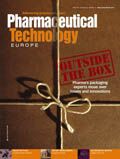Packaging Considerations
Pharmaceutical Technology Europe
There are a number of points to consider where secondary packaging is concerned.
Editor's Note: This article is part of a special feature on packaging that was published in the May issue of PTE Digital.
There are a number of points to consider where secondary packaging is concerned. In most cases, the secondary pack has to fulfil dual roles of product protection and product information; both of which are arguably more important in pharma compared with other industries because of the nature of the product.
Product protection falls into two categories. The first is physical protection. Will the carton withstand physical shocks? Is it substantial enough to maintain integrity throughout the supply chain? The second category is brand protection, which has been at the top of the pharma industry's agenda for years. Anti-counterfeiting strategies, which may involve both covert and overt features, as well as item-level serialisation, can also influence many aspects of the packaging.
On-pack product information strategies are often influenced by the category of the product (e.g., prescription only, OTC) and the relative importance of product branding. Needless to say, on-shelf appeal has a significant impact on the design of every aspect of OTC packaging!
Common to all pharma products is the requirement for variable data, including batch/lot codes and expiry dates. Some countries also operate reimbursement schemes that require a specific label or vignette to be applied. Most legislation require variable data in human-readable format, but in future, as a result of the EU's Falsified Medicines Directive, data will also need to be incorporated in Data Matrix format for products to be sold within EU markets covered by the directive.
Pharma manufacturers and their suppliers are used to complying with regulations, but this doesn't mean that regulations don't present challenges. One recent example is the need to incorporate Braille onto packaging, which became mandatory for new Marketing Authorisations in 2005. Since 30 October 2010, it has been mandatory for all packs to bear the product name and strength in Braille. Some manufacturers also use accessible media packaging that assists the visually impaired by speaking product information aloud.
The Falsified Medicines Directive will also present challenges, with the industry potentially having to re-evaluate every stockkeeping unit to ensure that there is adequate space and an appropriate surface to apply the new information.
Last but not least, child-resistant and senior-friendly strategies are increasingly in the spotlight. The ideal pack is one that, through a combination of cognitive and physical capabilities, allows ease of access for adults, but remains strictly off-limits for minors.
Innovation
A number of innovations can be seen in pharma packaging. Some boost brand profile or protect the brand by frustrating the counterfeiters. Others can boost product protection or enhance patient compliance. One example of a novel pack with multiple benefits is the walletstyle packs. In the competitive OTC arena, such packs are popular for their portability and branding opportunities. Many also offer high childresistant and seniorfriendly properties. Some innovations respond to more than one of these objectives. The Burgopak sliding blister pack, for example, was originally developed for its marketing appeal, but has subsequently proved to have substantial benefits in terms of improved patient compliance and child-resistant and senior-friendly properties.
Environmental responsibility is also high on the list of pharma's priorities and often forms part of the supplier qualification process where new contracts are concerned. While regulations governing pharmaceutical packaging may seem to militate against radical changes, major steps have been taken in the area of greener packaging. For example, pharmaceuticals are required by law to accommodate certain patient information. Traditionally, this has been in the form of a leaflet that is folded and inserted into the carton. However, the use of leaflet labels means that for some presentations (notably bottles), the product information can actually be applied directly to the product, which makes the carton superfluous. This can radically reduce a product's carbon footprint.
Another notable trend is the move away from recycled materials to virgin board. While this might seem counter-intuitive, virgin board has a significantly improved environmental impact compared with recycled materials because of improved handling and lower ink absorption.
Pharmaceutical packaging is positive proof that regulation doesn't necessarily stifle innovation!
Stephen Kemp is business development director at Brecon Pharmaceuticals.

Drug Solutions Podcast: A Closer Look at mRNA in Oncology and Vaccines
April 30th 2024In this episode fo the Drug Solutions Podcast, etherna’s vice-president of Technology and Innovation, Stefaan De Koker, discusses the merits and challenges of using mRNA as the foundation for therapeutics in oncology as well as for vaccines.